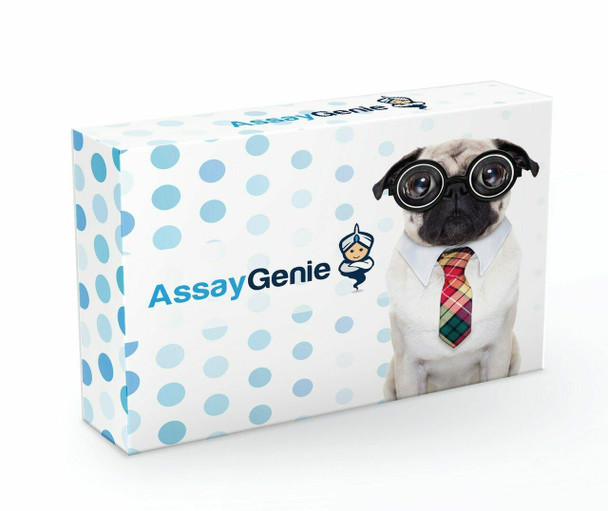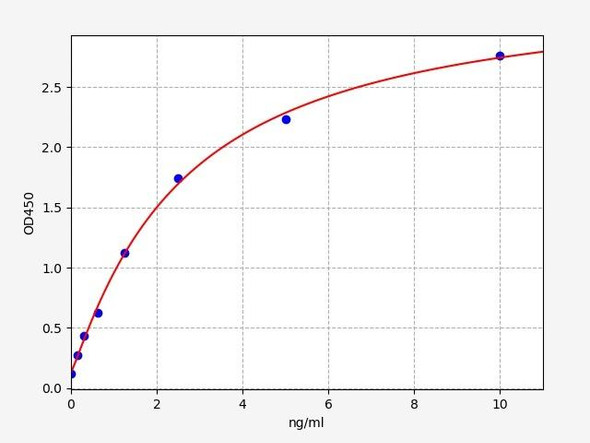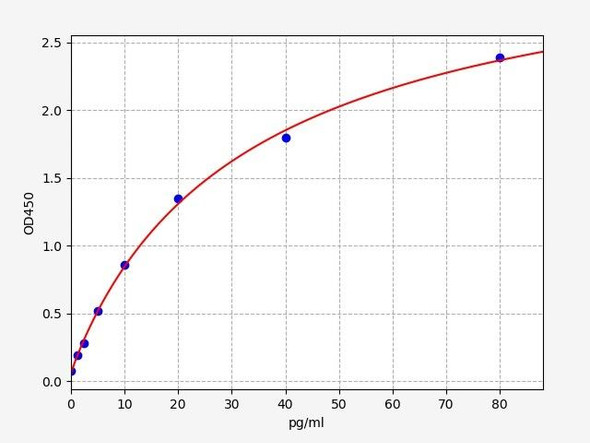Human UNC13A/Munc13-1 ELISA Kit (HUFI05805)
- SKU:
- HUFI05805
- Product Type:
- ELISA Kit
- Size:
- 96 Assays
- ELISA Type:
- Sandwich
- Synonyms:
- UNC13A/Munc13-1
- Reactivity:
- Human
Description
Human UNC13A/Munc13-1 ELISA Kit (HUFI05805)
The human UNC13A/Munc13-1 ELISA Kit (HUFI05805) is an immunoassay kit that allows for convenient in-vitro quantitative determination of human UNC13A/Munc13-1 concentration in different biological fluids, including serum plasma.
Key Features
| Save Time | Pre-coated 96 well plate | |
| Quick Start | Kit includes all necessary reagents | |
| Publication Ready | Reproducible and reliable results |
Overview
| Contact Technical Support | |
| Product Name: | Human UNC13A/Munc13-1 ELISA Kit |
| Product Code: | HUFI05805 |
| Size: | 96 Assays |
| Alias: | UNC13A/Munc13-1 ELISA Kit |
| Detection method: | Sandwich ELISA, Double Antibody |
| Application: | This immunoassay kit allows for the in vitro quantitative determination of Human UNC13A/Munc13-1 concentrations in serum plasma and other biological fluids. |
| Sensitivity: | Contact Technical Support |
| Range: | Contact Technical Support |
| Storage: | 4°C for 6 months |
| Note: | For Research Use Only |
Additional Information
| Recovery | Matrices listed below were spiked with certain level of Human UNC13A/Munc13-1 and the recovery rates were calculated by comparing the measured value to the expected amount of Human UNC13A/Munc13-1 in samples. Enquire for more information. |
| Linearity: | The linearity of the kit was assayed by testing samples spiked with appropriate concentration of Human UNC13A/Munc13-1 and their serial dilutions. The results were demonstrated by the percentage of calculated concentration to the expected. Enquire for more information. |
| CV(%): | Intra-Assay: CV<8% |
Kit Components
| Component | Quantity | Storage |
| ELISA Microplate (Dismountable) | 8×12 strips | 4°C for 6 months |
| Lyophilized Standard | 2 | 4°C/-20°C |
| Sample/Standard Dilution Buffer | 20ml | 4°C |
| Biotin-labeled Antibody(Concentrated) | 120ul | 4°C (Protect from light) |
| Antibody Dilution Buffer | 10ml | Text |
| HRP-Streptavidin Conjugate(SABC) | 120ul | 4°C (Protect from light) |
| SABC Dilution Buffer | 10ml | 4°C |
| TMB Substrate | 10ml | 4°C (Protect from light) |
| Stop Solution | 10ml | 4°C |
| Wash Buffer(25X) | 30ml | 4°C |
| Plate Sealer | 5 | - |
Other materials required:
- Microplate reader with 450 nm wavelength filter
- Multichannel Pipette, Pipette, microcentrifuge tubes and disposable pipette tips
- Incubator
- Deionized or distilled water
- Absorbent paper
- Buffer resevoir
Protocol
*Note: Protocols are specific to each batch/lot. For the exact instructions please follow the protocol included in your kit.
Before adding to wells, equilibrate the SABC working solution and TMB substrate for at least 30 min at 37°C. When diluting samples and reagents, they must be mixed completely and evenly. It is recommended to plot a standard curve for each test.
| Step | Procedure |
| 1. | Set standard, test sample and control (zero) wells on the pre-coated plate respectively, and then, record their positions. It is recommended to measure each standard and sample in duplicate. Wash plate 2 times before adding standard, sample and control (zero) wells! |
| 2. | Aliquot 0.1ml standard solutions into the standard wells. |
| 3. | Add 0.1 ml of Sample / Standard dilution buffer into the control (zero) well. |
| 4. | Add 0.1 ml of properly diluted sample ( Human serum, plasma, tissue homogenates and other biological fluids.) into test sample wells. |
| 5. | Seal the plate with a cover and incubate at 37 °C for 90 min. |
| 6. | Remove the cover and discard the plate content, clap the plate on the absorbent filter papers or other absorbent material. Do NOT let the wells completely dry at any time. Wash plate X2. |
| 7. | Add 0.1 ml of Biotin- detection antibody working solution into the above wells (standard, test sample & zero wells). Add the solution at the bottom of each well without touching the side wall. |
| 8. | Seal the plate with a cover and incubate at 37°C for 60 min. |
| 9. | Remove the cover, and wash plate 3 times with Wash buffer. Let wash buffer rest in wells for 1 min between each wash. |
| 10. | Add 0.1 ml of SABC working solution into each well, cover the plate and incubate at 37°C for 30 min. |
| 11. | Remove the cover and wash plate 5 times with Wash buffer, and each time let the wash buffer stay in the wells for 1-2 min. |
| 12. | Add 90 µl of TMB substrate into each well, cover the plate and incubate at 37°C in dark within 10-20 min. (Note: This incubation time is for reference use only, the optimal time should be determined by end user.) And the shades of blue can be seen in the first 3-4 wells (with most concentrated standard solutions), the other wells show no obvious color. |
| 13. | Add 50 µl of Stop solution into each well and mix thoroughly. The color changes into yellow immediately. |
| 14. | Read the O.D. absorbance at 450 nm in a microplate reader immediately after adding the stop solution. |
Sample Preparation
When carrying out an ELISA assay it is important to prepare your samples in order to achieve the best possible results. Below we have a list of procedures for the preparation of samples for different sample types.
| Sample Type | Protocol |
| Serum | If using serum separator tubes, allow samples to clot for 30 minutes at room temperature. Centrifuge for 10 minutes at 1,000x g. Collect the serum fraction and assay promptly or aliquot and store the samples at -80°C. Avoid multiple freeze-thaw cycles. If serum separator tubes are not being used, allow samples to clot overnight at 2-8°C. Centrifuge for 10 minutes at 1,000x g. Remove serum and assay promptly or aliquot and store the samples at -80°C. Avoid multiple freeze-thaw cycles. |
| Plasma | Collect plasma using EDTA or heparin as an anticoagulant. Centrifuge samples at 4°C for 15 mins at 1000 × g within 30 mins of collection. Collect the plasma fraction and assay promptly or aliquot and store the samples at -80°C. Avoid multiple freeze-thaw cycles. Note: Over haemolysed samples are not suitable for use with this kit. |
| Urine & Cerebrospinal Fluid | Collect the urine (mid-stream) in a sterile container, centrifuge for 20 mins at 2000-3000 rpm. Remove supernatant and assay immediately. If any precipitation is detected, repeat the centrifugation step. A similar protocol can be used for cerebrospinal fluid. |
| Cell culture supernatant | Collect the cell culture media by pipette, followed by centrifugation at 4°C for 20 mins at 1500 rpm. Collect the clear supernatant and assay immediately. |
| Cell lysates | Solubilize cells in lysis buffer and allow to sit on ice for 30 minutes. Centrifuge tubes at 14,000 x g for 5 minutes to remove insoluble material. Aliquot the supernatant into a new tube and discard the remaining whole cell extract. Quantify total protein concentration using a total protein assay. Assay immediately or aliquot and store at ≤ -20 °C. |
| Tissue homogenates | The preparation of tissue homogenates will vary depending upon tissue type. Rinse tissue with 1X PBS to remove excess blood & homogenize in 20ml of 1X PBS (including protease inhibitors) and store overnight at ≤ -20°C. Two freeze-thaw cycles are required to break the cell membranes. To further disrupt the cell membranes you can sonicate the samples. Centrifuge homogenates for 5 mins at 5000xg. Remove the supernatant and assay immediately or aliquot and store at -20°C or -80°C. |
| Tissue lysates | Rinse tissue with PBS, cut into 1-2 mm pieces, and homogenize with a tissue homogenizer in PBS. Add an equal volume of RIPA buffer containing protease inhibitors and lyse tissues at room temperature for 30 minutes with gentle agitation. Centrifuge to remove debris. Quantify total protein concentration using a total protein assay. Assay immediately or aliquot and store at ≤ -20 °C. |
| Breast Milk | Collect milk samples and centrifuge at 10,000 x g for 60 min at 4°C. Aliquot the supernatant and assay. For long term use, store samples at -80°C. Minimize freeze/thaw cycles. |
UNC13A Background
UNC13A Background
UNC13A, also known as Unc-13 homolog A, is a gene identified in humans. Located on chromosome 19, it plays a crucial role in neurotransmitter release, particularly in synaptic vesicle exocytosis, which is the process by which neurotransmitters are released from nerve cells (neurons) into the synapse, the small gap between neurons.
Munc13-1 Protein
The UNC13A gene encodes a protein called Munc13-1, which is primarily expressed in the brain and is found at high levels in neurons. Munc13-1 is involved in the docking and priming of synaptic vesicles at the active zones of synapses, which enables the efficient release of neurotransmitters upon neuronal signaling.
Protein Structure of MUNC13-1 (Source: Uniprot)
Significance in disease
Mutations or dysregulation of the UNC13A gene have been associated with various neurological conditions and disorders. For instance, studies have linked alterations in UNC13A to increased susceptibility to epilepsy, a neurological disorder characterized by recurrent seizures. These mutations may disrupt the normal functioning of neurotransmitter release, leading to aberrant neuronal activity. It has also been implicated in autism spectrum disorders (ASDs). Although the precise mechanisms by which UNC13A contributes to these conditions are not fully understood, research suggests that disruptions in synaptic vesicle release and neurotransmitter signaling may play a role in the pathogenesis of these disorders.
UNC13A and Amyotrophic Lateral Sclerosis (ALS)
ALS is a devastating neurodegenerative disorder characterized by a lack of effective treatments and an incomplete understanding of its underlying mechanisms. While genomewide association studies (GWAS) have provided valuable insights into the disease, the specific ways in which risk polymorphisms contribute to ALS pathogenesis are still not fully elucidated. Notably, GWAS have revealed that a specific polymorphism (rs12608932) in the UNC13A gene is associated with increased risk for both ALS and frontotemporal dementia (FTD), another neurodegenerative condition. This finding highlights the potential involvement of UNC13A in the development and progression of these diseases, suggesting that further investigation of its role may shed light on shared mechanisms or pathways involved in ALS and FTD.
UNC13A/Munc13-1 Fact Sheet
| Gene Name | UNC13A |
| Gene ID | 23025 |
| Uniprot ID | Text |
| Full Name | Protein unc-13 homolog A |
| Protein Family | UNC13 |
Human UNC13A/Munc13-1 ELISA Kit FAQs
Q: What is the purpose of the UNC13A ELISA kit?
This UNC13A ELISA kit is specifically designed to measure the levels of human UNC13A protein in biological samples. It allows researchers to quantify the expression of UNC13A, which is involved in neurotransmitter release and has implications in various neurological disorders.
Q: What type of samples can be used with the UNC13A ELISA kit?
The UNC13A ELISA kit is suitable for biological fluids such as serum samples
Q: Can the UNC13A ELISA kit be used for diagnostic purposes?
While the UNC13A ELISA kit can provide valuable insights into UNC13A expression, it is primarily intended for research purposes. It can aid in biomarker discovery, investigating disease mechanisms, and evaluating potential therapeutic interventions.
Q: Is the UNC13A ELISA kit compatible with other species besides humans?
This UNC13A ELISA kit has been developed specifically for human samples. While it may cross-react with UNC13A protein from other species, it is recommended to consult the product manual or contact technical support for information regarding cross-reactivity.
Q: Where can I find additional technical support or assistance with the UNC13A ELISA kit?
For any technical inquiries or assistance regarding the UNC13A ELISA kit, you can reach out to our team. They will be available to answer your questions and provide the necessary guidance to ensure a successful experiment.









